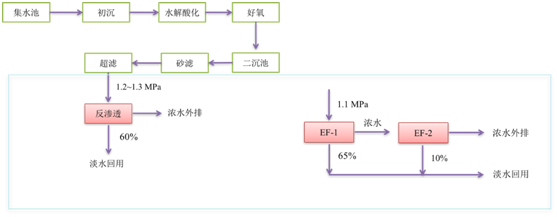China is relatively short of water resources, and with the further development of China's industrialization, the shortage of water resources is becoming more and more serious. At the same time, in the industrial production process, a large amount of industrial wastewater can be produced every day. If this part of wastewater can be reused by certain technical means, not only the industrial water can be reduced, but also the waste water treatment cost can be reduced, which has important social and economic significance.
As a newly emerging water treatment technology in recent decades, reverse osmosis technology is characterized by high desalination rate, environmental protection and wide range of water quality, etc., and is gradually used for industrial wastewater reuse. The specific process is shown in the figure. After the industrial wastewater is collected, it goes through a series of pretreatment, such as precipitation, into the ultrafiltration system to remove most of the turbidity and organic matter, and finally into the reverse osmosis system to further remove the small molecular organic matter and inorganic salt that can't be retained by ultrafiltration, so as to achieve water production and reuse. However, it is found that the removal rate of inorganic salt ions in industrial wastewater by reverse osmosis membrane module is almost 100% in the process of use, which leads to serious membrane surface concentration difference polarization, which not only requires high operating pressure and operating costs, but also is difficult to further improve the proportion of wastewater recovery.
E-MEM environmental, according to the water recycling needs, targeted development of two energy-saving membrane products EF-1, EF-2, instead of conventional reverse osmosis membrane components. Our country's textile printing and dyeing, each year about 6 ~ 700 million tons of printing and dyeing waste water discharged into water environment, accounting for 35% of the whole industrial wastewater emissions, so our company choose printing and dyeing wastewater as test water recycling, based on the recycling process, use EF - 1 instead of reverse osmosis membrane components, effectively reduce the operating pressure to 1.1 MPa, improve system recovery to 65%;At the same time, the concentrated water side of the EF-1 was directly connected to the EF-2 membrane module, and the driving force of the concentrated water residue of the EF-1 membrane module system was utilized to further obtain 10% water production, which reduced the overall system wastewater discharge rate from the initial 40% to 25%.Since this process only adds an EF-2 membrane module system and eliminates auxiliary equipment such as intermediate water tank, booster pump and high-pressure pump, the investment cost is limited.

(a) Routine process (b) Replacement of energy-saving film process
FIG. Industrial wastewater reuse process by reverse osmosis membrane process
集水池:water collecting tank 初沉:initial sedimentation 水解酸化:Hydrolytic acidification 好养:aerobic 超滤 UF 砂滤: sand filer 二沉池:second sedimentation 反渗透:RO 浓水外排:concentrated water drain 浓水回用:concentrated water reuse 浓水:concentrated water 浓水外排:concentrated drain
After the replacement for the energy-saving membrane water recycle system data listed in the table below, the data indicates that reverse osmosis membrane components change into membrane module EF-1 &install EF-2, the system pressure lower, system recovery higher, the electricity, chemical cleaning and depreciation of membrane element calculated, after using and EF-1 and EF-2, tons of water treatment costs will be reduced by more than 20%, suggests that energy saving membrane in the printing and dyeing wastewater and other industrial wastewater reuse has certain application prospect.
Table before and after the replacement of energy-saving memrbane
recycling system water quality parameters
|
pH |
CODcr(mg/l) |
SS (mg/l) |
chroma(time) |
conductivity(μs/cm) |
Total hardness (mg/l) |
||
|
Feed water |
7.0~8.5 |
~110 |
~4 |
~50 |
~5000 |
~250 |
|
|
Internal recycle standard |
6.0~9.0 |
≤50 |
≤1 |
≤10 |
≤500 |
≤200 |
|
|
System permeate before modification |
6.9 |
≤10 |
<1 |
0 |
60 |
<10 |
|
|
After modification water quality |
EF-1 |
7.0 |
≤10 |
<1 |
0 |
78 |
<10 |
|
EF-2 |
7.0 |
≤10 |
<1 |
0 |
543 |
<10 |
|
|
Mix |
7.0 |
≤10 |
<1 |
0 |
153 |
<10 |
|


